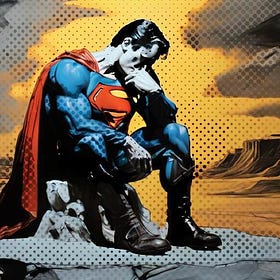Nietzsche made the beautiful remark: »Insanity in individuals is something rare — but in groups, parties, nations, and epochs, it is the rule.« While this assessment may be immediately obvious, it also brings a great embarrassment of thought: when Insanity becomes a mass phenomenon, it can no longer be read as such. Even worse: insofar as it’s able to disguise itself as economic rationale, at a certain time, it can seem to epitomize the reality principle to such an extent that even people who have retained a healthy skepticism join in this insane social game. The noughties, rushing in with all their might towards the great financial crisis, offered a fine exemplar of this, while many present-day trends also reveal delusional traits—the only difference being people aren’t getting caught up in financial bubbles anymore, but in a form of morality that articulates itself as apocalypticism, luxury faith, or virtue-signaling, whatever the case may be. And because you can convert your displayed nobility into hard cash, global players are also getting in on the act. Hence, it’s unsurprising that companies like JP Morgan boast about their diversity efforts: their moral superiority. There’s no doubt whatsoever that the political economy has given way to a moral economy, leading to a general warming of the heart – giving an invaluable advantage of avoiding accusations of base motives such as greed or profiteering. Incidentally, monetization has also become an epiphenomenon: as the pursuit of greater things continues, acceptance and follower numbers are reaching dizzying heights—and as the bubble captures ever larger population groups, it produces what C.G. Jung aptly called psychic inflation – and the pre-psychoanalytical Nietzsche ›Insanity‹. Now, a deeply egalitarian, carnivalesque side comes into play here, for moral indignation is, as Marshall McLuhan noted, »a technique used to endow the idiot with dignity.«1 Once the social level of indignation has sunk to an all-time low, the positional advantage it gives the individual shouldn’t be underestimated.
Because once you’ve forced yourself into a moral corset, you become utterly unassailable. Nevertheless, criticism, if it arises, can only be interpreted as an ad hominem attack. And because, instead of having to respond to the insult the Viennese way (Don’t even ignore it in the first place!), you have technical aids; all it takes is a single click: Blocked!
Which brings us all together...
But let’s not be put off by the present’s pretentiousness—rather, let’s work out the structural features of the collective phantasm instead. Don Quixote offers a good model insofar as the Knight of the Sad Countenance should be read not merely as an individual deviation – but as the portrait of an entire epoch; he’s the embodiment of the late Middle Ages, which, deeply entangled in the romantic narratives of chivalry, began tilting at Windmills. The fact that this narrative fragment has become a winged word and metaphor for extreme senselessness is a relieving-out of how any attempt to escape that overpowering order is doomed to failure. Why? It’s because here we deal with a Social Drive [Gesellschaftstriebwerk]—the Medieval Wheelwork [Räderwerkautomaten]—whose first manifestation is the windmill. And while Don Quixote’s caricature may amuse readers, the hero’s obvious madness is an exaggerated portrait of his contemporaries who couldn’t free themselves from a traditional worldview. If you read Don Quixote from this point of view, it’s evident you’re dealing with a structural similarity here. It’s not coincidental that the activism of our contemporaries seems like an attempt to tilt at the windmills of our time, whether it’s nuclear technology or the digitalised operating system. Much of what’s considered progressive behavior turns out to be a profoundly regressive movement when viewed from close up – as if we could return to the womb of Gaia, to that state of nature when wind and sun didn’t yet send bills.
Take the great debate sparked by the trans issue that’s been codified into a legislative form as the Self-Determination Act. While sitting in front of a computer game, anyone who has had the opportunity of choosing their avatar, equipping it with any desired superpowers – and the gender of their choice – will immediately understand how our society is confronted with a new freedom of thought—what we commonly call virtuality.
Isn’t this freedom a new kind of desire as a form of digitalised transphilia promising unprecedented pleasures and possibilities—and with such a fluid concept of identity in front of us, it’s hardly surprising that we dream of leaving our biological boundaries behind. On the other hand, this virtual space is existentialistically [essentialistisch]2 as a new sense of self— even a distinct identity—is a disconcerting short-circuit reminiscent of the Spanish nobleman’s decision to finally knight himself after reading countless chivalric novels.
What’s more, if this computer loan has turned into a zealous form of Identity Politics where alleged progressives can castigate the rest of the world as transphobic—even misanthropic, then this zealous Manicheanism heralds back to long-forgotten times, even giving the impression that alleged progressives are storming back into a dark age with all their might. Consequently, we deal with religious warriors evading the present’s impositions by restaging the past’s battles, which raises a question that the belief in progress has always overlooked. If Victor Hugo claimed that ›there’s nothing more powerful than an idea whose time has come,‹ then this thought should be corrected to say that ›there’s nothing more powerful than an idea whose time has passed.‹ Why? Because yesterday’s worldview, auratically over-glorified, has taken on such self-evidence that the very idea of its historicity is an absurdity—as wonderfully exemplified by the bon mot that ›it’s easier to think the end of the world than the end of Capitalism.‹ And there’s another advantage: once such a worldview has been detached from daily practice, it magically regains its Ideal clout. Not only does it give you a perfect stratagem you can use to keep the present’s impositions at bay as »Great again!«—but anyone cloaking themselves in this vintage costume can also feel like a hero of bygone times – without having to undergo any complicated spiritual exercises – as the ghost of being chosen for individual greatness quickly joins gratitude. This second-hand logic, characterizing Quixote, is a complicated World pressing itself into its narrative scheme, in which everything fits into familiar patterns where, like Penny Dreadfuls, you’re dealing with the usual suspects, the same old challenges and the same old solutions. And because such a Worldview Machine is easy to learn and runs like clockwork, having been tried and tested over centuries, its phantasy overrides the perception of the World. More precisely: it creates those phantastic overpaintings that give Don Quixote’s story its comedic flavoring – while, in the worldview of the terrible simplificateur, such overpaintings are the rule as a psychological mechanism of compulsion. Consequently, passing merchants are transformed into villainous knights, flocks of sheep into hostile armies, windmills into giants against whom one must march, and everything becomes experienced as casus belli. And this is perhaps the most striking signature of Don Quixote, namely that he undauntedly charges against everything contrary to his chivalrous disposition—or at least what he believes to be so. In this sense, we can almost recognize the Ideal image of an activist in him, who knows he’s on the right side of history beyond a shadow of a doubt. If he must take a heavy beating in the fight against a superior force, he consoles himself that he’s running against people who, unlike him, haven’t been knighted and, therefore, aren’t capable of satisfaction. If his self-awareness touches the boundary of electness or even a savior complex, the paradox remains that everything he knows about knighthood is nothing more than the fruit of his reading. As a result, even the procedure of knighting is an enigma to him, and it’s only thanks to the impatience of the run-down innkeeper that he gets rid of this burdensome duty with a courageous blow.
But the crucial question remains: What’s characteristic of this delusional system? What’s the fault that ignites Quixotism? First of all, it should be noted that everything we’ve become accustomed to calling Leon Festinger’s ›cognitive dissonance‹ referring to any explanations an individual gives themselves in their attempts at drowning out the dissonance—points to a loss of reality in which an uncanny, even illegible perception overpainted by an Ideal in such a way that seamlessly fits it into a predetermined narrative, and what makes this framing so exquisite is how the protagonist’s understanding of his role and belief system isn’t affected in the least. This is illustrated by a scene in the book's second part where, together with his soothsaying monkey, the puppeteer Pedro appears in the same inn where Don Quixote and Sancho Panza are staying. The play begins after a highly skeptical Don Quixote has eyed the monkey’s divinatory abilities but admires the puppet show. However, when the puppeteer describes the location of the action as the city of Zaragoza, which the Moors have taken, he makes what Don Quixote considers to be an unforgivable mistake. When he says the whole city is drowning in the ringing of bells from all of the mosques – this doesn’t correspond to reality, so Don Quixote interrupts and corrects him: Moors don’t have bells, only timpani and a kind of wooden flute; and, in any case, the ringing of bells in Sansueña is a serious perversity. While this intervention may reflect a specific sense of reality, something strange happens a little later. When the Moors pursue the fleeing heroes in the puppet show, Don Quixote can no longer hold on to himself and now must intervene in the action himself – no longer with words, but physically:
»Don Quixote, however, seeing such a swarm of Moors and hearing such a din, thought it would be right to aid the fugitives, and standing up he exclaimed in a loud voice, »Never, while I live, will I permit foul play to be practised in my presence on such a famous knight and fearless lover as Don Gaiferos. Halt! ill-born rabble, follow him not nor pursue him, or ye will have to reckon with me in battle!«
But because the puppets won’t abandon their puppet show, the hero – »One man, one word,« as the text puts it - springs into action and destroys the entire puppet theater, with the puppeteer screaming for help:
»But in spite of this, Don Quixote did not leave off discharging a continuous rain of cuts, slashes, downstrokes, and backstrokes, and at length, in less than the space of two credos, he brought the whole show to the ground, with all its fittings and figures shivered and knocked to pieces, King Marsilio badly wounded, and the Emperor Charlemagne with his crown and head split in two.«
Here, we come to a crucial point of Quixotism: the inability to read a symbol as such. This symbolic ataraxia precisely characterizes the figure of thought known as ›social constructivism.‹ It asserts that any self-image—race, gender, identity—is nothing more than a social attribution. Conversely, it can be deduced from this statement that any identity can be appropriated through a speech act. However, paradoxically, this transforms what previously worked as a relativization into a gesture of self-empowerment. From now on, individuals will not only claim such-and-such Identity for themselves but will also emphasize this Identity’s uniqueness – while informing everyone of their newly acquired Identity’s exclusiveness and privilege. Recalling Don Quixote’s gesture of self-empowerment, the parallel is striking. For if his knighthood owes itself solely to reading – and the knighthood remains an enigma, we’re dealing with a phantasm of greatness, indeed a presumption which, because it doesn’t rest in itself, feels constantly challenged. Consequently, Don Quixote, with his honor already wounded by the action of a puppet theater, goes on the attack: »One man, one word.« So fragile is this second-hand Identity that even symbols are experienced as violations, even as a violent threat. It’s no coincidence social constructivism, which strides towards self-empowerment, exhibits a similar sensitivity – an idiosyncrasy that sees itself exposed to microaggressions everywhere—and even exaggerates silence into an act of violence. In response, its first step is to purge language of anything deemed impure – and if anyone, in defiance, dares to express themselves inappropriately, the language police’s surveillance as there’s no hesitation, and they go into battle—except that this turmoil—is on Twitter, X, Facebook, or wherever—taking the form of a digitalised puppet show.
What makes identitarian self-empowerment so unique is that it's been given the force of law in some countries. And this enveloping is precisely what makes Quixotism a form of social Insanity. However, this pathologization is just as unhelpful as the never-ending moral outrage surrounding it. Instead, we should ask what aberration is the underlying problem. When Don Quixote initially tilts at windmills, Cervantes has already provided the answer: With this tempest, we’re defending ourselves against that symbolic order that’s ending the heroism of the bygone, oh-so-golden overly-glamorized times. This process didn't begin during Miguel de Cervantes's lifetime but was already emerging in the 12th and 13th centuries. When the Wheelwork Automaton struck the Gothic era like a comet, it plunged the epoch into a kind of constitutional schizophrenia. Thus, seeds were sown for a literary genre which, in the shape of Amadis de Gaulle, took on the form so eagerly consumed by the Knight of the Sad Countenance. When I said earlier that there's nothing more powerful than an Idea whose time has passed, this is demonstrated by the historical reception of this genre. Book circulation in the 14th century was limited to manuscripts—each costing the annual salary of a craftsman—but with Gutenberg's printing press, they became a mass product. As Lucien Febvre and Henri-Jean Martin write in their L'apparation de livre, the 15th and 16th centuries were more familiar with medieval thought patterns than the Middle Ages themselves.
It's no coincidence that Miguel de Cervantes, on the occasion of a book burning scene in his Don Quixote, writes a meticulous dissection of all the chivalric novels preceding it. Bearing in mind that the author's résumé is at a maximum distance from the adventure stories of Amadis de Gaulle, we realize that Don Quixote (which has been celebrated as the archetype of the modern novel) is, above all, the deconstruction of a social phantasm, indeed that the Knight of the Sad Countenance must be understood as a collective figure, a proto-type whose adventures stand for a collective destiny. Seen in this light, Cervantes' novel isn't about the madness of an individual—but about the madness of the times and dealing with the phantom pains of a lost worldview by conjuring up the Ghosts of the past. And because they've shed the weight of the world, having shrunken down to handy Penny Dreadfuls, it's all the easier to indulge in them. When asked about the detachment of his theory, the philosopher Hegel is said to have replied: »All the worse for the fact. «—this corresponds to the logic of Quixotism: for the Ideal, freed from all reality, can be used most effectively against a complex world that’s become illegible. So Don Quixote tells Sancho Panza—who points out to him that the supposed giants are actually windmills, »and what seem to be their arms are the sails that turned by the wind make the millstone go.«—that he’s obviously ignorant in matters of adventure: In other words, he lacks the correct enframing narrative. Just as it's said that every problem becomes a nail for a person who only possesses a hammer, reality undergoes a reconfiguration in such a way that what’s illegible is transformed into the prevailing narrative. Thus, the energetic superiority in the hero's head is transformed into a giant figure against which he wants to enter into a »fierce and unequal battle.« If this heroism can't be convinced, it can emerge victorious; it's because the goal isn't overcoming the opponent but maintaining your self-image. The resolute will is articulated here – not to power – but to powerlessness. This may seem paradoxical, but the flight into self-victimization certainly has advantages – otherwise, whole armies wouldn't follow it. In this way, the magic of the familiar remains intact, and we don't have to deal with complicated ambiguities. In terms of our age, you could say that by insisting on a whatever-you-want identity, you're relieved of the imposition of having to alphabetize yourself digitally. Protect Me from What I Want.
Translation: Martin Burckhardt and Hopkins Stanley
This means that the stupidity bonus [dummenbonus] of the DotCom bubble has also experienced the appropriate refinement.
Essentialistisch is translated roughly as existentialistically, which refers to something that becomes an essential characteristic that doesn’t work out in real life [IRL]. Here, it can be thought of as a misread symbol that becomes fantastical in what seems to be a misinterpretation of what’s progressive. Exempla would be the de-transitioning movement happening in the wake of the politicization of the trans movement; another would be de-industrialization and rising energy costs from the progressive existentialistical thinking of our climate activists.
Related Topics
The Bill of Identity
The following open letter addresses the German Self-Determination Act. Although based on laudable intentions, it does have a few oddities or identity traps that are humorously pointed out. This form of legislation is not unique to Germany, but is globally en vogue (or should one say:
Greener than Green
»What times are these when / A conversation about trees is almost a crime / Because it includes silence about so many misdeeds!« (Bertolt Brecht)













